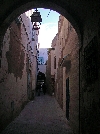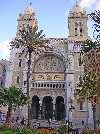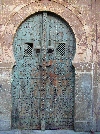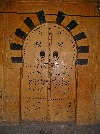
Tunisia Odyssey: Historic North
Bicycle Africa / Ibike Tours
Dispatch 1 - Tunis
Program options: Cathedral, monuments, markets, medina, medersa, mosques and mausoleums.
After arriving in the afternoon
and settling in to the hotel, we set off to look around the city center:
On a walk up Avenue Habib Bourguiba it never seems to take long to be pick-up by
a friendly tout
tell you about a special exhibition in the medina where carpets playing a
prominent role. He'll ask your nationality, where in country you are from, where
we were staying, etc. then gave us some vague directions and waved good-bye.
With a sigh of relief of how easy it was to get out of the conversation you'll
relax. A very short time later a second tout will hail you as though he
knew you. What a coincidence, he works at the same hotel you are staying at, had
seen you there (or at least when you walked out the front doors ten minutes
earlier), he is off duty now. As you are searching you brain for images of
every desk clerk, bell boy and room attendant at the hotel so as not to be
offensive, he is going on that by the way, he knows of a great exhibition, it is
the last day, can show he where it is. Because of you good manners and the
doubt that he has created, usually number two is very hard to shake and despite
you better judgment and gut reaction you acquiesce and find yourself led to his
uncles carpet shop. These shops seem to have one-way doors -- they are
very easier to walk into, but no easier to walk out of empty handed than it was
to turn down number two.
Throughout the city most of the
merchandising is done by small ground floor shops so most street make for an
interesting stroll. Click here for an sidetrip excursion
to Carthage
 Wandering the streets of Tunis you feel you could be anywhere in the world
as far as traffic, buildings, and other inorganic are concerned. In
most of the ways that I can think of Tunis is incongruous with the
headlines about Africa of the Arab world, and it is different
from Europe as well. Yet, simultaneously there are element that are clearly has associations with
all three regions. There is both a business-likeness and relax-here element to Habib Bourguiba Blvd, the main street.
Wandering the streets of Tunis you feel you could be anywhere in the world
as far as traffic, buildings, and other inorganic are concerned. In
most of the ways that I can think of Tunis is incongruous with the
headlines about Africa of the Arab world, and it is different
from Europe as well. Yet, simultaneously there are element that are clearly has associations with
all three regions. There is both a business-likeness and relax-here element to Habib Bourguiba Blvd, the main street.
 One end is anchored by an obelisk clock town and the other by the Tunisian
born historian
One end is anchored by an obelisk clock town and the other by the Tunisian
born historian
 Ibn
Khaldoun (1332-1406). Khaldoun is considered the greatest of
Arab historians. He wrote Kitab al-Ibar (Universal History), where he
was the first to treated history as a
Ibn
Khaldoun (1332-1406). Khaldoun is considered the greatest of
Arab historians. He wrote Kitab al-Ibar (Universal History), where he
was the first to treated history as a
 science
and outlined a philosophy of history. In the center of the strip is
the Italianate National Theater. Any litter is gone.
The street trees are pruned and the gardens are manicured, and wide sidewalks
are lined with outdoor
seating from numerous coffee shops. Display windows are smartly set-out
and there is a purposeful flow of conservative, stylishly dressed people
filling the sidewalk -- though stylishness is
science
and outlined a philosophy of history. In the center of the strip is
the Italianate National Theater. Any litter is gone.
The street trees are pruned and the gardens are manicured, and wide sidewalks
are lined with outdoor
seating from numerous coffee shops. Display windows are smartly set-out
and there is a purposeful flow of conservative, stylishly dressed people
filling the sidewalk -- though stylishness is
 changing and conservativeness
is being challenged. Though most women are still most covered from
neck, to neck, to
ankle, for the young women the coverage is increasing being achieved with
tight (underscore) jeans and tight sweats -- which don't pass unnoticed by
the men, young and old, passing the time at the sidewalk coffee shops.
Gone almost completely, in the central city, are the safsari, large plain
cloths, the women used to cover themselves with from head to ankle when they
go
out in public, to give them a very formless shape. For young men the
defining element of fashion seems to be well coiffed hair and a leather
jacket. You are more likely to see two men or two women walking arm
in arm than you are to see a man and a woman because of the conservative
culture, influenced as it is by Islam. Mixed sex couples garner glances,
if not stares, as they pass.
changing and conservativeness
is being challenged. Though most women are still most covered from
neck, to neck, to
ankle, for the young women the coverage is increasing being achieved with
tight (underscore) jeans and tight sweats -- which don't pass unnoticed by
the men, young and old, passing the time at the sidewalk coffee shops.
Gone almost completely, in the central city, are the safsari, large plain
cloths, the women used to cover themselves with from head to ankle when they
go
out in public, to give them a very formless shape. For young men the
defining element of fashion seems to be well coiffed hair and a leather
jacket. You are more likely to see two men or two women walking arm
in arm than you are to see a man and a woman because of the conservative
culture, influenced as it is by Islam. Mixed sex couples garner glances,
if not stares, as they pass. As many people seem to be
moving by foot as all the other modes combined (cars, taxi, buses and tram).
This might explain the large number of shoe stores. Another
As many people seem to be
moving by foot as all the other modes combined (cars, taxi, buses and tram).
This might explain the large number of shoe stores. Another
 popular mode of travel is the tram. From morning rush hour until evening they
ran full through the center of town. Bicyclist are very rare
-- as are bicycle shops. (If you need a bicycle or bicycle part, Madrid
street is the place to look, but the selection is limited.)
popular mode of travel is the tram. From morning rush hour until evening they
ran full through the center of town. Bicyclist are very rare
-- as are bicycle shops. (If you need a bicycle or bicycle part, Madrid
street is the place to look, but the selection is limited.)
 There
are only a couple of sky-scrapers in the city, so even from the newer "French Quarter" you
see mostly the irregular roofline of 2, 3 and 4 story buildings, with lots
of sky. This changes in the old quarter where the streets are narrow and
cozy and most of the buildings are only two-story.
There
are only a couple of sky-scrapers in the city, so even from the newer "French Quarter" you
see mostly the irregular roofline of 2, 3 and 4 story buildings, with lots
of sky. This changes in the old quarter where the streets are narrow and
cozy and most of the buildings are only two-story.
 The
passages are so narrow you are in a big human maze, if
the walls weren't concrete you could
image yourself waking through canyons of
The
passages are so narrow you are in a big human maze, if
the walls weren't concrete you could
image yourself waking through canyons of trees. In the French-designed section
of town the main street has a half-block wide tree shaded promenade down the
center. Its is festooned with park benches and
kiosks selling flowers, newspapers, postcards, books and
trees. In the French-designed section
of town the main street has a half-block wide tree shaded promenade down the
center. Its is festooned with park benches and
kiosks selling flowers, newspapers, postcards, books and other small items.
Along the sides of the boulevard, there are a
variety of shops that might be on a main commercial street anywhere;
pastries, clothing boutiques, shoes, books, general merchandise, coffee shops
and restaurants. And then there is the Catholic Cathedral St Vincent DePaul,
banks, hotels and official buildings.
other small items.
Along the sides of the boulevard, there are a
variety of shops that might be on a main commercial street anywhere;
pastries, clothing boutiques, shoes, books, general merchandise, coffee shops
and restaurants. And then there is the Catholic Cathedral St Vincent DePaul,
banks, hotels and official buildings.

 Though tourism is one of the main industries
in the country, it is not until you get on to the rabbit warren, narrow streets of the "World Heritage Site"
medina (old
walled city) that
you find a mass of curio shops – with a lot to sell, but very few T-shirts. Throughout the medina there is a wide variety of textiles, brass work, leather
jackets, bag and pillows,
Though tourism is one of the main industries
in the country, it is not until you get on to the rabbit warren, narrow streets of the "World Heritage Site"
medina (old
walled city) that
you find a mass of curio shops – with a lot to sell, but very few T-shirts. Throughout the medina there is a wide variety of textiles, brass work, leather
jackets, bag and pillows,
 hand
woven and tied carpets, pottery, jewelry, glass works, wood carvings and
multimedia things -- they are
selling anything you could possibly want and lots you wouldn’t want. Though there are dozen of shops selling the same kinds of
items and competition for customers must be tough, as long as you don’t linger
too long or look too long the sales atmosphere is relatively low pressure. There
are so many colors, shapes, textures and materials it is hard to take it all in.
It is a "visual jazz". Very stimulating window shopping.
hand
woven and tied carpets, pottery, jewelry, glass works, wood carvings and
multimedia things -- they are
selling anything you could possibly want and lots you wouldn’t want. Though there are dozen of shops selling the same kinds of
items and competition for customers must be tough, as long as you don’t linger
too long or look too long the sales atmosphere is relatively low pressure. There
are so many colors, shapes, textures and materials it is hard to take it all in.
It is a "visual jazz". Very stimulating window shopping.

 As
As large as the
tourist souq (market) is, the markets catering to
Tunisians are even larger. In these markets you can get clothes,
shoes, cloth, perfume, hats, food, spices, jewelry,
toys, Arabic books, plumbing
supplies, etc. To some extent merchants with the same kinds of
products are clustered together so there are jewelry sections, rug sections,
furniture section, vegetable sections, etc.
large as the
tourist souq (market) is, the markets catering to
Tunisians are even larger. In these markets you can get clothes,
shoes, cloth, perfume, hats, food, spices, jewelry,
toys, Arabic books, plumbing
supplies, etc. To some extent merchants with the same kinds of
products are clustered together so there are jewelry sections, rug sections,
furniture section, vegetable sections, etc. Encapsulated in the medina is a lot of history as well: Among the
many mosques we passed was the Jamaa Ez Zitouna (Mosque of the Olive
Tree) or
Great Mosque with hundreds pillars that had been removed from the ruins of Roman
Carthage in the ninth
Encapsulated in the medina is a lot of history as well: Among the
many mosques we passed was the Jamaa Ez Zitouna (Mosque of the Olive
Tree) or
Great Mosque with hundreds pillars that had been removed from the ruins of Roman
Carthage in the ninth century. The Place du Government where the Prime
Minister and other notables worked was also a favorite area with its
beautiful courtyard replete with large fountains and shade trees. We past
the
century. The Place du Government where the Prime
Minister and other notables worked was also a favorite area with its
beautiful courtyard replete with large fountains and shade trees. We past
the
 "Turkish" Youssef Dey Mosque, through many of the traditional markets and here items were grouped together
creating their own specialty souq: wool souq, cotton
"Turkish" Youssef Dey Mosque, through many of the traditional markets and here items were grouped together
creating their own specialty souq: wool souq, cotton
 souq,
jewelry souq, perfume souq, book souq, and slave souq.
Another type of historic places are the medersas or Islamic schools:
Medersas Mouradia, Medersas Slimania, Medersas Bachia and Medersas of the Palm
Tree.
souq,
jewelry souq, perfume souq, book souq, and slave souq.
Another type of historic places are the medersas or Islamic schools:
Medersas Mouradia, Medersas Slimania, Medersas Bachia and Medersas of the Palm
Tree.
 And
then there are the tourbet (burial chambers) theme. The largest of
these is the Tourbet el Bey, mausoleum of more than a century and a half
(1705-1881) of Husseinid sovereigns, princes, princesses and high government
officials. All along our route were good examples
of the ornate doors of Tunis. A fixture of the
less traveled by-ways were cats. Obviously
enjoying the lack of traffic in the early morning as they were everywhere
underfoot.
And
then there are the tourbet (burial chambers) theme. The largest of
these is the Tourbet el Bey, mausoleum of more than a century and a half
(1705-1881) of Husseinid sovereigns, princes, princesses and high government
officials. All along our route were good examples
of the ornate doors of Tunis. A fixture of the
less traveled by-ways were cats. Obviously
enjoying the lack of traffic in the early morning as they were everywhere
underfoot.
 The Dar
Othman Palace, now the home of the association designated to
conserve the medina, was probably our favorite stop. It
is one of the nicest palace in Tunis with a variety of architectural styles from
the tenth century.
The Dar
Othman Palace, now the home of the association designated to
conserve the medina, was probably our favorite stop. It
is one of the nicest palace in Tunis with a variety of architectural styles from
the tenth century.
 It is a beautiful building
both for its interior detail and outdoor open space. After the close confines of the streets, the large
courtyard with full sized trees and a large swath of blue sky were
refreshing. It
It is a beautiful building
both for its interior detail and outdoor open space. After the close confines of the streets, the large
courtyard with full sized trees and a large swath of blue sky were
refreshing. It emphasized, as no amount of reading can do,
emphasized, as no amount of reading can do,
 the reality of
the Arabic lifestyle: Western
style is to have lots of windows to look out on beautiful landscapes while
the Arabs focus inwardly with drab exteriors, few to no windows, but
wonderful courtyards and interior open spaces. This building was a great
example of this latter style.
the reality of
the Arabic lifestyle: Western
style is to have lots of windows to look out on beautiful landscapes while
the Arabs focus inwardly with drab exteriors, few to no windows, but
wonderful courtyards and interior open spaces. This building was a great
example of this latter style. Not
far off the main street is Tunis' Jewish synagogue. Jews have been in
Tunisia for more than 2000 years. Up until the 1970's the country had a
significant Jewish population, with active synagogues in all of the major
cities. Except for on Djerba, the population is dwindling and aging,
with most of the young people immigrating to France and other European
destinations.
Not
far off the main street is Tunis' Jewish synagogue. Jews have been in
Tunisia for more than 2000 years. Up until the 1970's the country had a
significant Jewish population, with active synagogues in all of the major
cities. Except for on Djerba, the population is dwindling and aging,
with most of the young people immigrating to France and other European
destinations.![]()
 For
dinner we walked around the corner from the hotel where is a row straight-up
Tunisian "diner" where, collectively, we sampled the menu: mechioua ( a grilled salad with grilled peppers and
onions with lettuce, tomatoes, and canned tuna), briq (egg and
things, often tuna, fried in phyla dough), ojja (poached eggs,
sautéed bell pepper and
For
dinner we walked around the corner from the hotel where is a row straight-up
Tunisian "diner" where, collectively, we sampled the menu: mechioua ( a grilled salad with grilled peppers and
onions with lettuce, tomatoes, and canned tuna), briq (egg and
things, often tuna, fried in phyla dough), ojja (poached eggs,
sautéed bell pepper and
 onion
in tomato sauce), Sfaxian rice (spiced rice
with seafood) and couscous, served with an
unending supply of French bread. One of the remnants of the French
culture in their former colonies is the bread -- for those who like it, it
is comfort food around the world. Most
Tunisian couscous is very fine, with only only had well baked vegetables and a piece of
lamb, chicken or fish on top, and not served with a lot of sauce.
Done right it is very moist and flavorful. People used to
seeing it covered with a heavy sauce might worried that it will be dry. They
are then pleasantly surprised that it's light, moist and, tasty, with a nice
consistency.
onion
in tomato sauce), Sfaxian rice (spiced rice
with seafood) and couscous, served with an
unending supply of French bread. One of the remnants of the French
culture in their former colonies is the bread -- for those who like it, it
is comfort food around the world. Most
Tunisian couscous is very fine, with only only had well baked vegetables and a piece of
lamb, chicken or fish on top, and not served with a lot of sauce.
Done right it is very moist and flavorful. People used to
seeing it covered with a heavy sauce might worried that it will be dry. They
are then pleasantly surprised that it's light, moist and, tasty, with a nice
consistency.
Addendum
Doors of Tunis:
One symbol of Tunis is its
doors. There are hundreds of beautiful doors. Here is a very
small sample:
![]()
![]()
Unique Programs To Special Places For Memories Of A Lifetime!
![]()
![]() Please
write if you have questions, suggestions and comments about our program or want to be
added to Bicycle Africa's mailing list. (Also let us know how you found this site.)
Please
write if you have questions, suggestions and comments about our program or want to be
added to Bicycle Africa's mailing list. (Also let us know how you found this site.)





